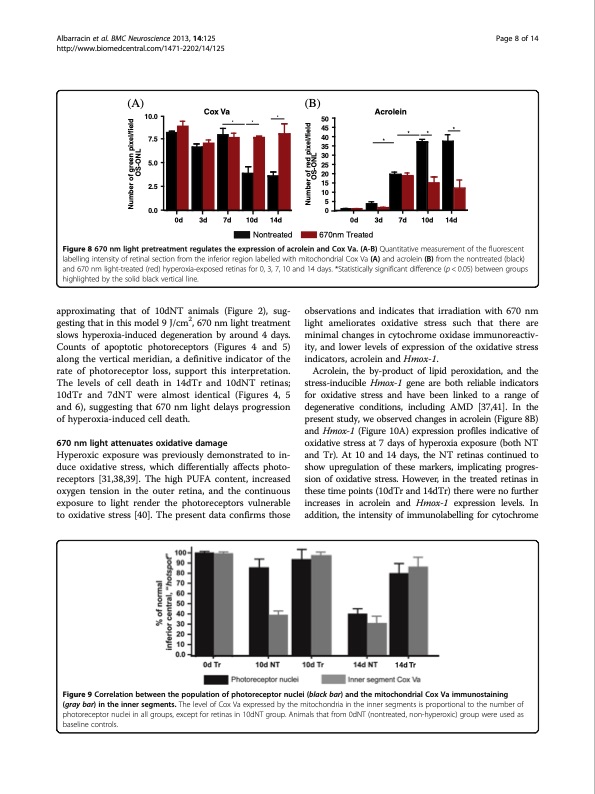
PDF Publication Title:
Text from PDF Page: 009
Albarracin et al. BMC Neuroscience 2013, 14:125 http://www.biomedcentral.com/1471-2202/14/125 Page 8 of 14 (A) 10.0 7.5 5.0 2.5 0.0 Cox Va (B) Acrolein ** * * 50 45 40 35 30 25 20 15 10 5 0 ** * 0d 3d 7d 10d 14d Nontreated 0d 3d 7d 10d 14d Figure 8 670 nm light pretreatment regulates the expression of acrolein and Cox Va. (A-B) Quantitative measurement of the fluorescent labelling intensity of retinal section from the inferior region labelled with mitochondrial Cox Va (A) and acrolein (B) from the nontreated (black) and 670 nm light-treated (red) hyperoxia-exposed retinas for 0, 3, 7, 10 and 14 days. *Statistically significant difference (p < 0.05) between groups highlighted by the solid black vertical line. 670nm Treated approximating that of 10dNT animals (Figure 2), sug- gesting that in this model 9 J/cm2, 670 nm light treatment slows hyperoxia-induced degeneration by around 4 days. Counts of apoptotic photoreceptors (Figures 4 and 5) along the vertical meridian, a definitive indicator of the rate of photoreceptor loss, support this interpretation. The levels of cell death in 14dTr and 10dNT retinas; 10dTr and 7dNT were almost identical (Figures 4, 5 and 6), suggesting that 670 nm light delays progression of hyperoxia-induced cell death. 670 nm light attenuates oxidative damage Hyperoxic exposure was previously demonstrated to in- duce oxidative stress, which differentially affects photo- receptors [31,38,39]. The high PUFA content, increased oxygen tension in the outer retina, and the continuous exposure to light render the photoreceptors vulnerable to oxidative stress [40]. The present data confirms those observations and indicates that irradiation with 670 nm light ameliorates oxidative stress such that there are minimal changes in cytochrome oxidase immunoreactiv- ity, and lower levels of expression of the oxidative stress indicators, acrolein and Hmox-1. Acrolein, the by-product of lipid peroxidation, and the stress-inducible Hmox-1 gene are both reliable indicators for oxidative stress and have been linked to a range of degenerative conditions, including AMD [37,41]. In the present study, we observed changes in acrolein (Figure 8B) and Hmox-1 (Figure 10A) expression profiles indicative of oxidative stress at 7 days of hyperoxia exposure (both NT and Tr). At 10 and 14 days, the NT retinas continued to show upregulation of these markers, implicating progres- sion of oxidative stress. However, in the treated retinas in these time points (10dTr and 14dTr) there were no further increases in acrolein and Hmox-1 expression levels. In addition, the intensity of immunolabelling for cytochrome 14d Tr Figure 9 Correlation between the population of photoreceptor nuclei (black bar) and the mitochondrial Cox Va immunostaining (gray bar) in the inner segments. The level of Cox Va expressed by the mitochondria in the inner segments is proportional to the number of photoreceptor nuclei in all groups, except for retinas in 10dNT group. Animals that from 0dNT (nontreated, non-hyperoxic) group were used as baseline controls. Number of green pixel/field OS-ONL Number of red pixel/field OS-ONLPDF Image | 670 nm light mitigates oxygen-induced degeneration

PDF Search Title:
670 nm light mitigates oxygen-induced degenerationOriginal File Name Searched:
1471-2202-14-125.pdfDIY PDF Search: Google It | Yahoo | Bing
Cruise Ship Reviews | Luxury Resort | Jet | Yacht | and Travel Tech More Info
Cruising Review Topics and Articles More Info
Software based on Filemaker for the travel industry More Info
The Burgenstock Resort: Reviews on CruisingReview website... More Info
Resort Reviews: World Class resorts... More Info
The Riffelalp Resort: Reviews on CruisingReview website... More Info
| CONTACT TEL: 608-238-6001 Email: greg@cruisingreview.com | RSS | AMP |